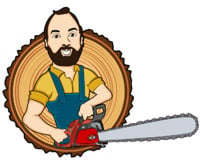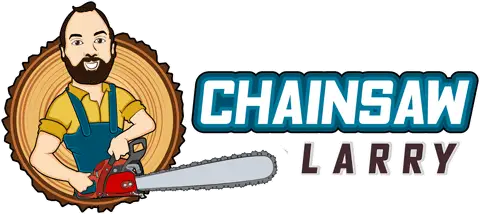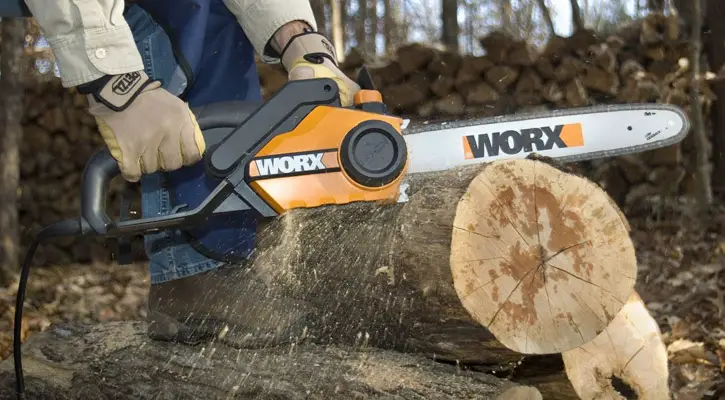Table of Contents
Are you thinking about buying an electric chainsaw?
Or maybe you just brought one home for the first time?
Either way, if you’re looking for tips on how to use an electric chainsaw, then this guide is for you.
Below, I’ll teach you everything you need to know about using an electric chainsaw in 10 easy steps.
If you are in the market for purchasing an electric chainsaw, be sure to visit my best corded electric chainsaw page. It shows you how to find the right tool for all of your cutting needs.
Enjoy!
How to Use an Electric Chainsaw
Safety First
Safety should always be your number one priority when using an electric chainsaw. Accidents can happen at any time, no matter how careful you are using the tool.
So, follow these safety tips each and every time you use an electric chainsaw.
For specific product recommendations, take a look at my chainsaw protective gear list.
- Always wear plastic goggles/safety glasses when cutting. Your eyes are delicate and cannot be replaced. Safety goggles prevent tiny bits of wood and sawdust from damaging your eyes.
- Wear a safety helmet. Especially when cutting around other trees. Limbs can fall at any moment and flying debris can hit your scalp.
- Wear hearing protection. Chainsaws are loud machines and can damage your hearing if used for long periods of time without hearing protection.
- Use cut-resistant gloves. This provides extra safety against the chainsaw blade and flying bits of wood.
- Wear cut-resistant pants. This protects your legs against accidental cuts and flying wood scraps.
- Wear a long sleeve shirt. It will help to protect your arms while cutting.
- Wear steel-toed boots. Wood is dense and heavy and steel-toed boots will protect your feet from getting hurt or crushed.
Step 1: Check the Chain Tension
If the tension is too loose, the chain can fly off the chainsaw mid-cut and injure you.
Each chainsaw has a specific procedure for tensioning the chain, so read the owner’s manual to see how to do it. However, the general guidelines are as follows:
To check for the proper tension, pull the chain down from the bottom of the guide bar so two links are out and release it. The chain should snap back into position. If it doesn’t then the chain is too loose. If you can’t pull the chain links down, then the chain is too tight.
Step 2: Fill the Bar and Chain Oil Reservoir
Most chainsaws are compatible with SAE 30 oil, but read the owner’s manual to verify this. Some manufacturers recommend a specific bar and chain oil, so fill the chainsaw with the recommended oil.
Just like a car engine, using the wrong oil can damage your chainsaw. Using the right oil for your chainsaw does not differ from using the correct oil in your car.
Before each use, make sure that the bar and chain oil reservoir is full so that you have enough lubrication for your cutting job.
Step 3: Connect a Power Cord
Electric chainsaws require electrical power to operate but these machines don’t come supplied with their own extension cords. So, you’ll need to buy one and attach it to use the tool out in the field.
Make sure wherever you cut, you have enough cord to reach the job. Electric chainsaws can be plugged into a standard wall outlet, or to make it more portable, you can plug the electric chainsaw into the outlet from a generator.
Either way, make sure you plug the cord into the electricity source and that the cord can handle the amperage of your chainsaw.
Step 4: Start the Electric Chainsaw
Many electric chainsaws require you to push and hold a safety lock button before the switch trigger becomes operational.
Once the safety lock is engaged, press the trigger button to activate the spinning of the chain.
Step 5: Make Your First Cut
With the chain spinning, press the chainsaw blade against the wood with steady, firm pressure, but don’t force it.
Keep constant pressure on the wood with the chainsaw until you’re about 3/4 of the way through it, then ease the pressure to finish.
The chain should do all of the cutting, not the force or pressure from your arms.
If you find that you’re using a lot of pressure to get through your cuts, the chain may be dull and need to be sharpened.
It’s a good idea to always keep on of the best chainsaw files in your pocket.
Also while cutting, if your electric chainsaw has a manual bar and chain oiler, press the bulb every 30 seconds to oil the chain while you work. If your chainsaw has an automatic bar and chain oiler then you don’t have to do anything since it will automatically oil the chain for you.
Release the throttle when finished, allowing the chainsaw chain to stop spinning.
If you want to learn how to use an electric chainsaw to cut down (or fell) a tree, check out this guide on how to cut down a tree with a chainsaw.
Step 6: Repeat Cutting (As Necessary)
Repeat step 5 until you’re done cutting through all of the wood in your project.
Step 7: Turn Off the Electric Chainsaw
If your electric chainsaw has a power switch, move it to the off position so the tool is completely turned off.
Step 8: Unplug the Power Cord
Detach the power cord from the electric chainsaw and from the power source.
Step 9: Let the Electric Chainsaw Cool Down
Electric chainsaws can stay hot 10 or more minutes after your cutting job is complete. So, let the chainsaw cool down for 20 minutes so you don’t accidentally burn yourself on the hot motor or blade.
Step 10: Store the Electric Chainsaw
Storing your electric chainsaw after each use is very important to keep it in good condition and to prevent accidental injuries.
If you can, remove the chain from the blade so it is stored separately from the chainsaw. Otherwise, wrap the blade with a sheathe or put the chainsaw in a carrying case to keep the chain tips from being exposed.
Also, lightly lubricate the bar and chain of the electric chainsaw so they don’t dry out or rust while in storage.
Avoiding Kickback While Using Your Electric Chainsaw
Kickback occurs when the chain’s blade unexpectedly gets thrown back at you. This can cause serious cutting injuries. Below are the most common types of kickbacks and how to avoid them.
Rotational Kickback
Rotational kickback is extremely common and the most dangerous kickback. It happens when the tip of the chain nicks a hard object.
To avoid this kickback, never touch the tip of the bar and chain assembly to any wood or other objects. If you do, the spinning saw blade may kickback directly at you.
Linear Kickback
We usually know linear kickback as “pinching the chain”. When cutting a piece of wood and the chain gets pinched, the entire electric chainsaw can come back at you at full speed.
One way to avoid linear kickback is to make sure the wood you’re cutting is properly balanced between the cut you’re making and the end of the wood.
Linear kickback occurs most often when your cut is not supported on both sides.
Pull-in Kickback
Pull-in kickback occurs when your electric chainsaw hits something inside the wood, such as a nail. This kickback also occurs if the chainsaw strikes a branch at the other end of the cut.
To prevent pull-in kickback, it’s best to know the wood being cut and how it has been previously used or inspect it before attempting any type of cut.
Using an Electric Chainsaw is Easy
As you learned in this step-by-step guide, using an electric chainsaw is not that difficult.
All it takes is a few common techniques to get the chainsaw started and actively spinning to cut wood.
Just remember to always keep safety at the forefront of any cutting task you attempt. That way you can protect yourself from any injuries that might occur while using your electric chainsaw.
As a reminder, if you’re looking to buy your first electric chainsaw or want to upgrade an existing tool, check out my best corded electric chainsaw page. It shows you how to find the best electric chainsaw for your needs and what the top features are available.
I hope this guide on how to use an electric chainsaw helped.
Happy sawing!

Your pal,
Chainsaw Larry

